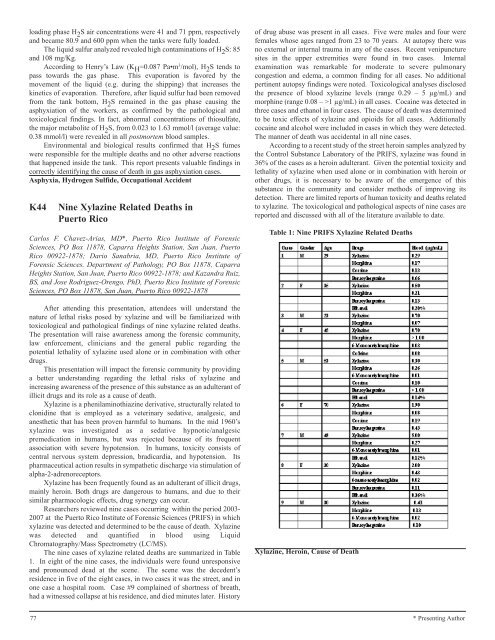FORENSIC TOXICOLOGY - Bio Medical Forensics
FORENSIC TOXICOLOGY - Bio Medical Forensics
FORENSIC TOXICOLOGY - Bio Medical Forensics
You also want an ePaper? Increase the reach of your titles
YUMPU automatically turns print PDFs into web optimized ePapers that Google loves.
loading phase H 2 S air concentrations were 41 and 71 ppm, respectively<br />
and became 80.9 and 600 ppm when the tanks were fully loaded.<br />
The liquid sulfur analyzed revealed high contaminations of H 2 S: 85<br />
and 108 mg/Kg.<br />
According to Henry’s Law (K H =0.087 Pa•m 3 /mol), H 2 S tends to<br />
pass towards the gas phase. This evaporation is favored by the<br />
movement of the liquid (e.g. during the shipping) that increases the<br />
kinetics of evaporation. Therefore, after liquid sulfur had been removed<br />
from the tank bottom, H 2 S remained in the gas phase causing the<br />
asphyxiation of the workers, as confirmed by the pathological and<br />
toxicological findings. In fact, abnormal concentrations of thiosulfate,<br />
the major metabolite of H 2 S, from 0.023 to 1.63 mmol/l (average value:<br />
0.38 mmol/l) were revealed in all postmortem blood samples.<br />
Environmental and biological results confirmed that H 2 S fumes<br />
were responsible for the multiple deaths and no other adverse reactions<br />
that happened inside the tank. This report presents valuable findings in<br />
correctly identifying the cause of death in gas asphyxiation cases.<br />
Asphyxia, Hydrogen Sulfide, Occupational Accident<br />
K44 Nine Xylazine Related Deaths in<br />
Puerto Rico<br />
Carlos F. Chavez-Arias, MD*, Puerto Rico Institute of Forensic<br />
Sciences, PO Box 11878, Caparra Heights Station, San Juan, Puerto<br />
Rico 00922-1878; Dario Sanabria, MD, Puerto Rico Institute of<br />
Forensic Sciences. Department of Pathology, PO Box 11878, Caparra<br />
Heights Station, San Juan, Puerto Rico 00922-1878; and Kazandra Ruiz,<br />
BS, and Jose Rodriguez-Orengo, PhD, Puerto Rico Institute of Forensic<br />
Sciences, PO Box 11878, San Juan, Puerto Rico 00922-1878<br />
After attending this presentation, attendees will understand the<br />
nature of lethal risks posed by xylazine and will be familiarized with<br />
toxicological and pathological findings of nine xylazine related deaths.<br />
The presentation will raise awareness among the forensic community,<br />
law enforcement, clinicians and the general public regarding the<br />
potential lethality of xylazine used alone or in combination with other<br />
drugs.<br />
This presentation will impact the forensic community by providing<br />
a better understanding regarding the lethal risks of xylazine and<br />
increasing awareness of the presence of this substance as an adulterant of<br />
illicit drugs and its role as a cause of death.<br />
Xylazine is a phenilaminothiazine derivative, structurally related to<br />
clonidine that is employed as a veterinary sedative, analgesic, and<br />
anesthetic that has been proven harmful to humans. In the mid 1960’s<br />
xylazine was investigated as a sedative hypnotic/analgesic<br />
premedication in humans, but was rejected because of its frequent<br />
association with severe hypotension. In humans, toxicity consists of<br />
central nervous system depression, bradicardia, and hypotension. Its<br />
pharmaceutical action results in sympathetic discharge via stimulation of<br />
alpha-2-adrenoreceptors.<br />
Xylazine has been frequently found as an adulterant of illicit drugs,<br />
mainly heroin. Both drugs are dangerous to humans, and due to their<br />
similar pharmacologic effects, drug synergy can occur.<br />
Researchers reviewed nine cases occurring within the period 2003-<br />
2007 at the Puerto Rico Institute of Forensic Sciences (PRIFS) in which<br />
xylazine was detected and determined to be the cause of death. Xylazine<br />
was detected and quantified in blood using Liquid<br />
Chromatography/Mass Spectrometry (LC/MS).<br />
The nine cases of xylazine related deaths are summarized in Table<br />
1. In eight of the nine cases, the individuals were found unresponsive<br />
and pronounced dead at the scene. The scene was the decedent’s<br />
residence in five of the eight cases, in two cases it was the street, and in<br />
one case a hospital room. Case #9 complained of shortness of breath,<br />
had a witnessed collapse at his residence, and died minutes later. History<br />
of drug abuse was present in all cases. Five were males and four were<br />
females whose ages ranged from 23 to 70 years. At autopsy there was<br />
no external or internal trauma in any of the cases. Recent venipuncture<br />
sites in the upper extremities were found in two cases. Internal<br />
examination was remarkable for moderate to severe pulmonary<br />
congestion and edema, a common finding for all cases. No additional<br />
pertinent autopsy findings were noted. Toxicological analyses disclosed<br />
the presence of blood xylazine levels (range 0.29 – 5 µg/mL) and<br />
morphine (range 0.08 – >1 µg/mL) in all cases. Cocaine was detected in<br />
three cases and ethanol in four cases. The cause of death was determined<br />
to be toxic effects of xylazine and opioids for all cases. Additionally<br />
cocaine and alcohol were included in cases in which they were detected.<br />
The manner of death was accidental in all nine cases.<br />
According to a recent study of the street heroin samples analyzed by<br />
the Control Substance Laboratory of the PRIFS, xylazine was found in<br />
36% of the cases as a heroin adulterant. Given the potential toxicity and<br />
lethality of xylazine when used alone or in combination with heroin or<br />
other drugs, it is necessary to be aware of the emergence of this<br />
substance in the community and consider methods of improving its<br />
detection. There are limited reports of human toxicity and deaths related<br />
to xylazine. The toxicological and pathological aspects of nine cases are<br />
reported and discussed with all of the literature available to date.<br />
Table 1: Nine PRIFS Xylazine Related Deaths<br />
Xylazine, Heroin, Cause of Death<br />
77 * Presenting Author






